check engine OLDSMOBILE SILHOUETTE 1997 Owner's Manual
[x] Cancel search | Manufacturer: OLDSMOBILE, Model Year: 1997, Model line: SILHOUETTE, Model: OLDSMOBILE SILHOUETTE 1997Pages: 436, PDF Size: 21.87 MB
Page 309 of 436
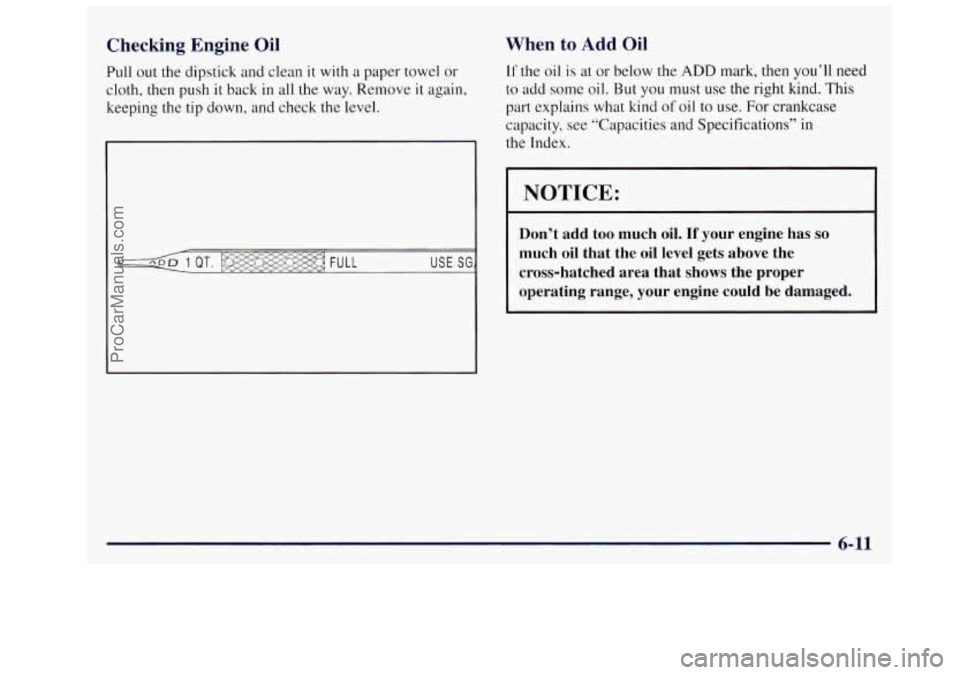
Checking Engine Oil
Pull out the dipstick and clean it with a paper towel or
cloth, then push
it back in all the way. Remove it again,
keeping the tip down, and check the level.
When to Add Oil
If the oil is at or below the ADD mark, then you’ll need
to add some oil. But you must use the right kind. This
part explains what kind
of oil to use. For crankcase
capacity, see “Capacities and Specifications” in
the Index.
I NOTICE:
Don’t add too much oil. If your engine has so
much oil that the oil level gets above the
cross-hatched area that shows the proper
operating range, your engine could be damaged.
6-11
ProCarManuals.com
Page 313 of 436
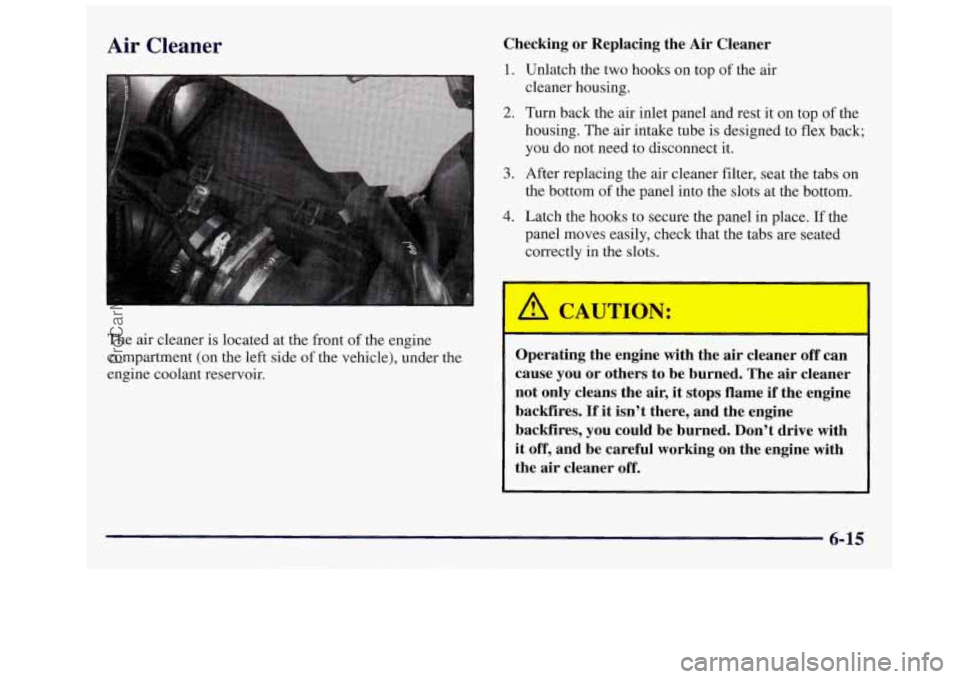
Air Cleaner
The air cleaner is located at the front of the engine
compartment (on the left side
of the vehicle), under the
engine coolant reservoir.
Checking or Replacing the Air Cleaner
1.
2.
3.
4.
Unlatch the two hooks on top of the air
cleaner housing.
Turn back the air inlet panel and rest it on top of the
housing. The air intake tube is designed to flex back;
you do not need to disconnect it.
After replacing the air cleaner filter, seat the tabs on
the bottom
of the panel into the slots at the bottom.
Latch the hooks to secure the panel in place.
If the
panel moves easily, check that the tabs
are seated
correctly in the slots.
-
Operating the engine with the air cleaner off can
cause you
or others to be burned. The air cleaner
not only cleans the air,
it stops flame if the engine
backfires.
If it isn’t there, and the engine
backfires, you could be burned. Don’t drive with
it off, and be careful working on the engine with
the air cleaner off.
6-15
ProCarManuals.com
Page 315 of 436
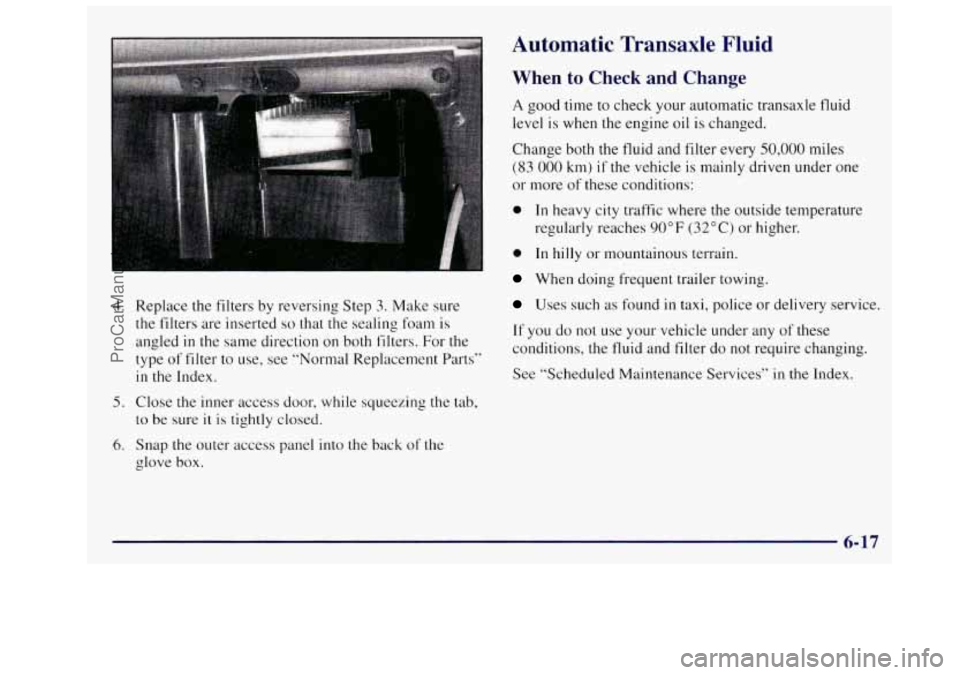
4.
5.
6.
Replace the filters by reversing Step 3. Make sure
the filters are inserted
so that the sealing foam is
angled
in the same direction on both filters. For the
type of filter to use,
see “Normal Replacement Parts”
in the Index.
Close the inner access door, while squeezing the tab,
to be sure
it is tightly closed.
Snap the outer access panel
into the back of the
glove box.
Automatic Transaxle Fluid
When to Check and Change
A good time to check your automatic transaxle fluid
level
is when the engine oil is changed.
Change both the fluid and filter every 50,000 miles
(83 000 km) if the vehicle is mainly driven under one
or more
of these conditions:
0 In heavy city traffic where the outside temperature
regularly reaches
90°F (32°C) or higher.
0 In hilly or mountainous terrain.
When doing frequent trailer towing.
Uses such as found in taxi, police or delivery service
If you do not use your vehicle under any of these
conditions, the fluid and filter do not require changing.
See “Scheduled Maintenance Services”
in the Index.
6-17
ProCarManuals.com
Page 316 of 436
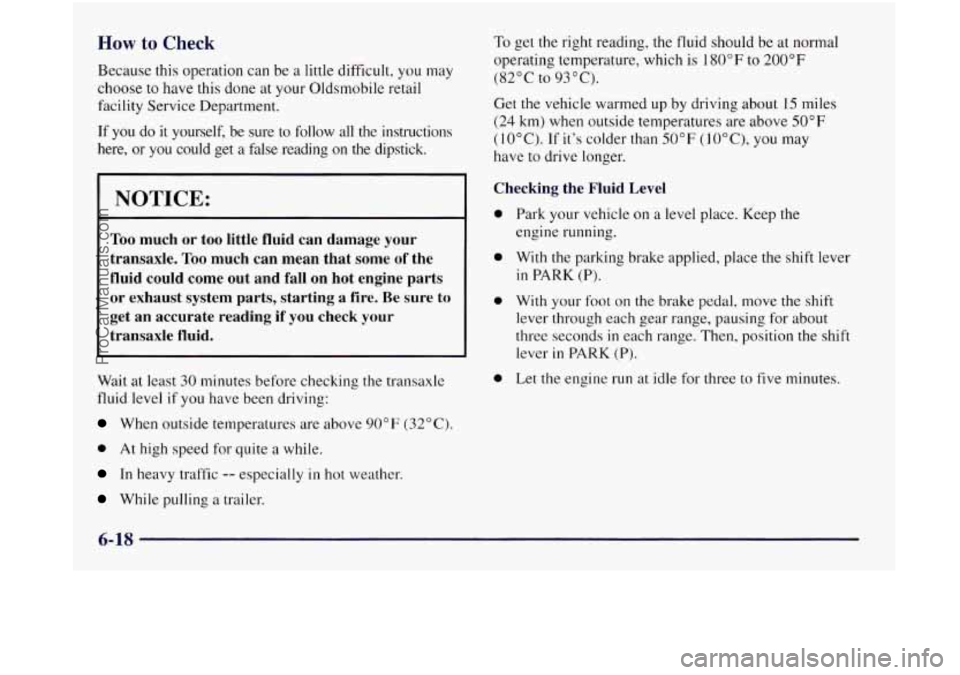
How to Check
Because this operation can be a little difficult, you may
choose to have this done at your Oldsmobile retail
facility Service Department.
If
you do it yourself, be sure to follow all the instructions
here, or you could get a false reading on
the dipstick.
NOTICE:
Too much or too little fluid can damage your
transaxle.
Too much can mean that some of the
fluid could come out and fall on hot engine parts
or exhaust system parts, starting a fire. Be
sure to
get an accurate reading if you check your
transaxle fluid.
Wait at least 30 minutes before checking the transaxle
fluid
level if you have been driving:
When outside temperatures are above 90°F (32°C).
To get the right reading, the fluid should be at normal
operating temperature, which is
180°F to 200°F
(82°C to 93°C).
Get the vehicle warmed up by driving about 15 miles
(24 km) when outside temperatures are above 50°F
(10°C). If it's colder than 50°F (lO"C), you may
have to drive longer.
Checking the Fluid Level
0
0
0
0
Park your vehicle on a level place. Keep the
engine running.
With the parking brake applied, place the shift lever
in PARK (P).
With your foot on the brake pedal, move the shift
lever through each gear range, pausing for about
three seconds
in each range. Then, position the shift
lever
in PARK (P).
Let the engine run at idle for three to five minutes.
0 At high speed for quite a while.
In heavy traffic -- especially in hot weather.
While pulling a trailer.
6-18
ProCarManuals.com
Page 317 of 436
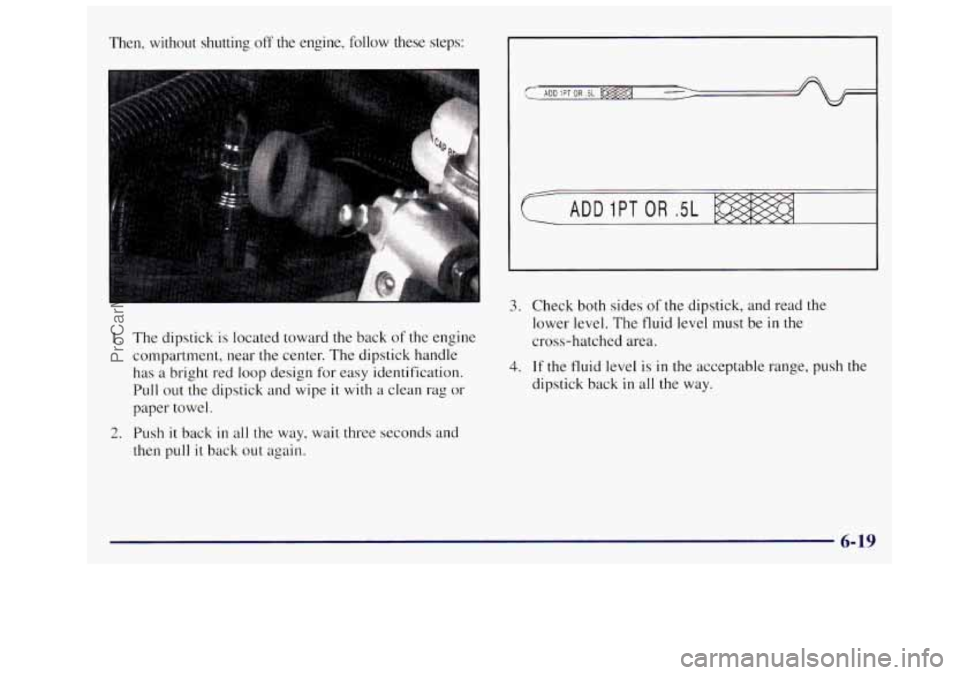
Then, without shutting off the engine, follow these steps:
1.
2.
The dipstick is located toward the back of the engine
compartment, near the center. The dipstick handle
has a bright red loop design for easy identification.
Pull out the dipstick and wipe it with a clean rag or
paper towel.
Push
it back in all the way, wait three seconds and
then pull
it back out again.
3. Check both sides of the dipstick, and read the
lower level. The fluid level must be
in the
cross-hatched area.
4. If the fluid level is in the acceptable range, push the
dipstick back in all the way.
6-19
ProCarManuals.com
Page 318 of 436
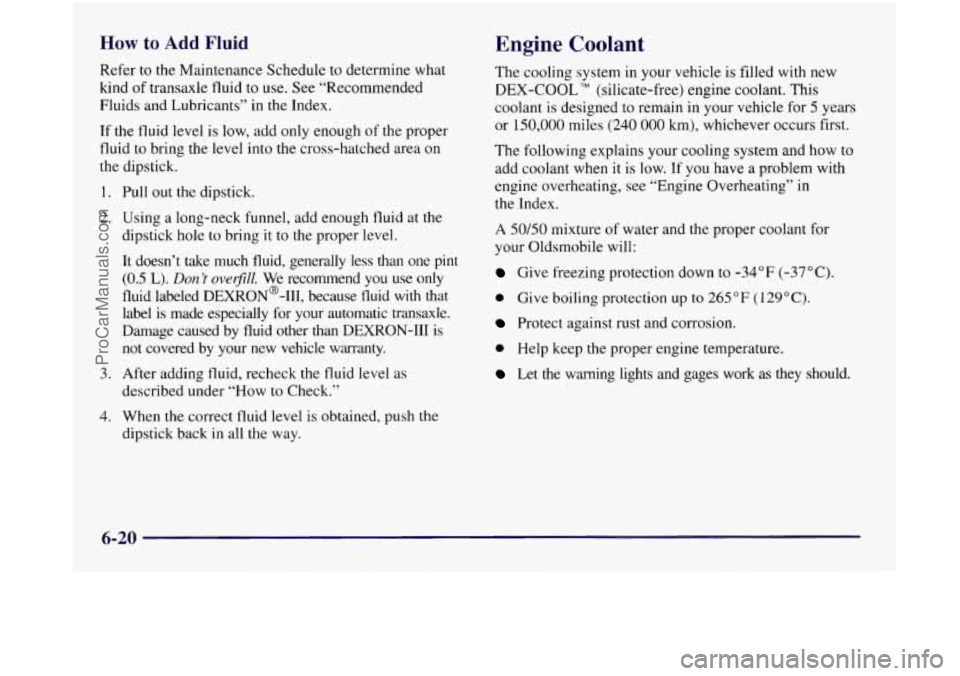
How to Add Fluid Engine Coolant
Refer to the Maintenance Schedule to determine what
kind
of transaxle fluid to use. See “Recommended
Fluids and Lubricants” in
the Index.
If the fluid level is low, add only enough of the proper
fluid to bring
the level into the cross-hatched area on
the dipstick.
1. Pull out the dipstick.
2. Using a long-neck funnel, add enough fluid at the
dipstick hole
to bring it to the proper level.
It doesn’t take much fluid, generally less than one pint
(0.5 L). Don% overfill. We recommend you use only
fluid labeled DEXRON@-111, because fluid with that label
is made especially for your automatic transaxle.
Damage caused by fluid other than DEXRON-111
is
not covered by your new vehicle warranty.
3. After adding fluid, recheck the fluid level as described under “How to Check.”
4. When the correct fluid level is obtained, push the
dipstick back in all the way. The cooling
system in your vehicle is filled with new
DEX-COOL
TM (silicate-free) engine coolant. This
coolant
is designed to remain in your vehicle for 5 years
or 150,000 miles
(240 000 km), whichever occurs first.
The following explains your cooling system and how to
add coolant when it is low. If you have a problem with
engine overheating, see “Engine Overheating” in
the Index.
A 50/50 mixture of water and the proper coolant for
your Oldsmobile will:
Give freezing protection down to -34°F (-37°C).
0 Give boiling protection up to 265°F (129°C).
Protect against rust and corrosion.
0 Help keep the proper engine temperature.
Let the warning lights and gages work as they should.
6-20
ProCarManuals.com
Page 320 of 436
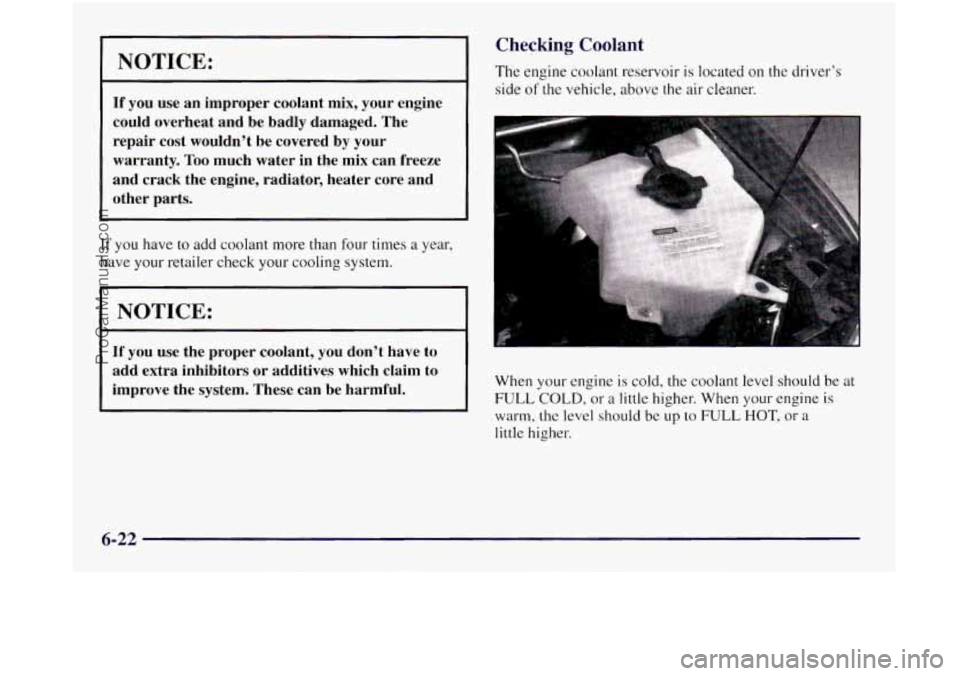
I NOTICE:
If you use an improper coolant mix, your engine
could overheat and be badly damaged. The
repair cost wouldn’t be covered by your
warranty.
Too much water in the mix can freeze
and crack the engine, radiator, heater core and other parts.
If you have to add coolant more than four times a year,
have your retailer check your cooling system.
NOTICE:
If you use the proper coolant, you don’t have to
add extra inhibitors or additives which claim
to
improve the system. These can be harmful.
Checking Coolant
The engine coolant reservoir is located on the urlver s
side of the vehicle, above the air cleaner.
When your engine is cold, the coolant level should be
at
FULL COLD, or a little higher. When your engine is
warm, the level should be up to FULL HOT, or a
little higher.
6-22
ProCarManuals.com
Page 323 of 436
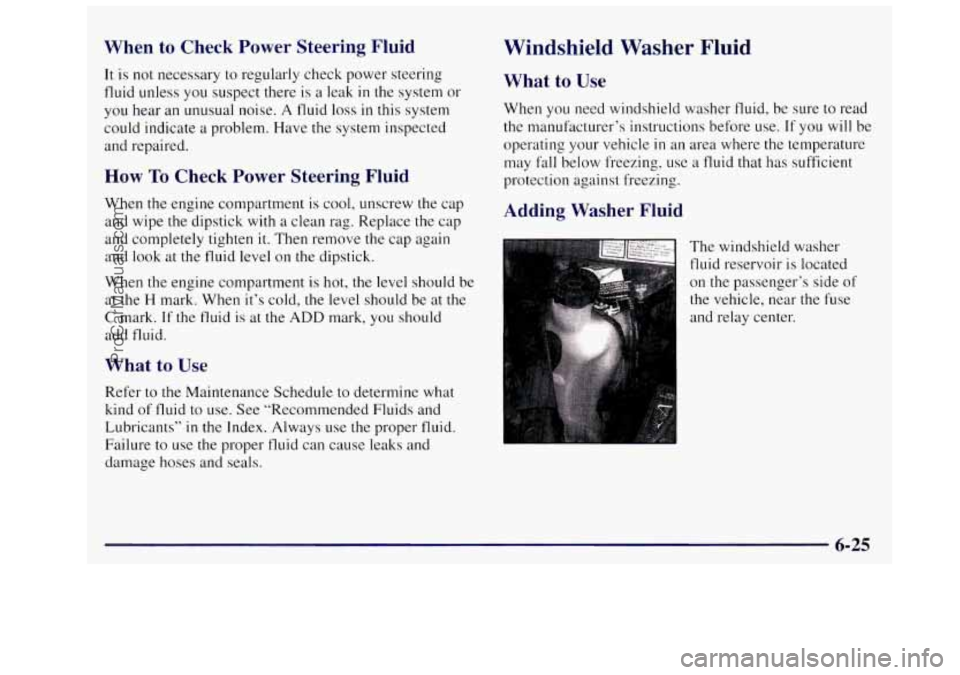
When to Check Power Steering Fluid
It is not necessary to regularly check power steering
fluid unless you suspect there
is a leak in the system or
you hear an unusual noise. A fluid loss in this system
could indicate
a problem. Have the system inspected
and repaired.
How To Check Power Steering Fluid
When the engine compartment is cool, unscrew the cap
and wipe the dipstick with
a clean rag. Replace the cap
and completely tighten
it. Then remove the cap again
and look at the fluid level on the dipstick.
When the engine compartment is hot,
the level should be
at the
H mark. When it’s cold, the level should be at the
C mark. If the fluid is at the ADD mark, you should
add fluid.
What to Use
Refer to the Maintenance Schedule to determine what
kind of fluid to use. See “Recommended Fluids and
Lubricants”
in the Index. Always use the proper fluid.
Failure to use the proper fluid can cause leaks and
damage hoses and seals.
Windshield Washer Fluid
What to Use
When you need windshield washer fluid, be sure to read
the manufacturer’s instructions before use.
If you will be
operating your vehicle
in an area where the temperature
may Pall below freezing, use
a fluid that has sufficient
protection against freezing.
Adding Washer Fluid
The windshield washer
fluid reservoir is located
on the passenger’s side of
the vehicle, near the fuse
6-25
ProCarManuals.com
Page 399 of 436
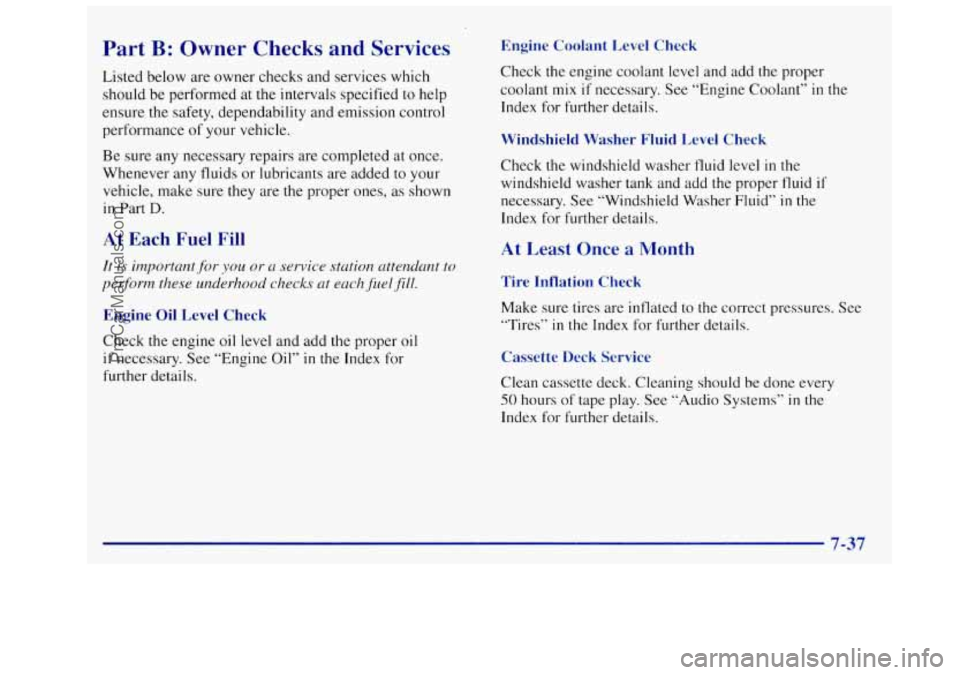
Part B: Owner Checks and Services
Listed below are owner checks and services which
should be performed at the intervals specified to help
ensure the safety, dependability and emission control
performance of your vehicle.
Be sure any necessary repairs are completed at once.
Whenever any fluids or lubricants are added to your
vehicle, make sure they are the proper ones,
as shown
in Part
D.
At Each Fuel Fill
It is importunt.for you or a service station attendant to
perform these underhood checks at each fuelfill.
Engine Oil Level Check
Check the engine oil level and add the proper oil
if necessary. See “Engine Oil” in the Index for
further details.
Engine Coolant Level Check
Check the engine coolant level and add the proper
coolant mix
if necessary. See “Engine Coolant’’ in the
Index for further details.
Windshield Washer Fluid Level Check
Check the windshield washer fluid level in the
windshield washer tank and add the proper fluid
if
necessary. See “Windshield Washer Fluid” in the
Index for further details.
At Least Once a Month
Tire Inflation Check
Make sure tires are inflated to the correct pressures. See
“Tires”
in the Index for further details.
Cassette Deck Service
Clean cassette deck. Cleaning should be done every
50 hours of tape play. See “Audio Systems” in the
Index for further details.
7-37
ProCarManuals.com
Page 401 of 436
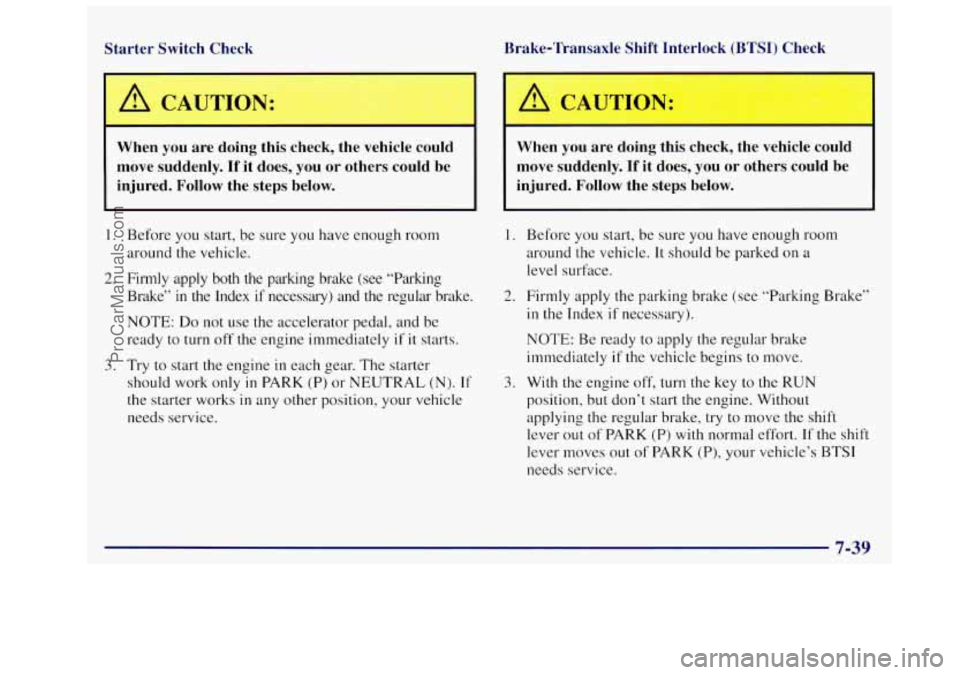
Starter Switch Check
A CAUTION:
When you are doing this check, the vehicle could
move suddenly.
If it does, you or others could be
injured. Follow the steps below.
I. Before you start, be sure you have enough room
around the vehicle.
2. Firmly apply both the parking brake (see “Parking
Brake”
in the Index if necessary) and the regular brake.
NOTE: Do not use the accelerator pedal, and be
ready to turn off the engine immediately
if it starts.
3. Try to start the engine in each gear. The starter
should work only
in PARK (P) or NEUTRAL (N). 1.f
the starter works in any other position, your vehicle
needs service.
Irake-Transaxle Shift Interlock (BTSI) Check
When you are doing this check, the vehicle could
move suddenly.
If it does, you or others could be
injured. Follow the steps below.
1.
2.
3.
Before you start, be sure you have enough room
around the vehicle. It should be parked on a
level surface.
Firmly apply the parking brake (see “Parking Brake”
in the Index if necessary).
NOTE: Be ready to apply the regular brake
immediately if
the vehicle begins to move.
With the engine off, turn the
key to the RUN
position, but don’t start
the engine. Without
applying
the regular brake, try to move the shift
lever out of PARK
(P) with normal effort. If the shift
lever moves out of
PARK (P), your vehicle’s BTST
needs service.
ProCarManuals.com